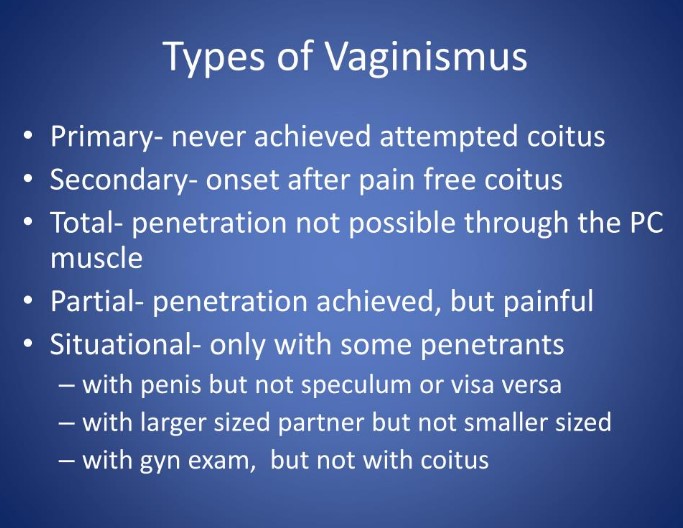Vaginismus Vulva Vaginal Pain
VAGINISMUS VULVA & VAGINAL PAIN — Vaginismus, a nuanced condition deserving our attention, manifests as an involuntary spasm or contraction of the muscles enveloping the vaginal entrance. Written by Aleena Aspley on 27-Jan-2024
This perplexing phenomenon can create significant challenges, rendering penetration not only painful but often impossible, sparking both personal and relational distress.
Picture this: an intricate network of muscles reacting involuntarily, triggered not just by attempts at intercourse but extending to the seemingly routine acts of inserting tampons, undergoing medical examinations, or even self-exploration.
Many women grappling with vaginismus describe the experience as if their body were putting up an impenetrable barrier—a sensation akin to ‘hitting a brick wall’ when trying to introduce something.
Understanding the complexities of vaginismus opens the door to empathy and awareness, unraveling the layers of this condition and shedding light on the diverse ways it impacts women’s lives.
.
.
.
.
VAGINISMUS
Vaginismus Vulva Vaginal Pain
The spectrum of how vaginismus presents itself varies significantly among women.
For some, the condition may allow them to insert a finger or undergo a medical examination without much difficulty.
On the other hand, there are those who, due to pain or intense muscle cramping, find it nearly impossible to insert anything into the vagina, and some may only manage to partially insert a penis.
It’s crucial to emphasize that, despite the challenges posed by vaginismus, many women affected by this condition can experience sexual arousal, and most possess a genuine desire for sexual intimacy with their partners.
The inability to engage in lovemaking becomes a source of profound frustration for these individuals, amplifying the emotional toll of vaginismus on their lives.
.
.
.
.
THERE ARE TWO TYPES
OF VAGINISMUS
Vaginismus Vulva Vaginal Pain
Primary Vaginismus — This type occurs when a woman has never been able to engage in vaginal penetration without pain.
It may be present from the first attempt at intercourse or the insertion of a tampon, making any form of penetration challenging.
Secondary Vaginismus — In this type, a woman who has had previous experiences of pain-free intercourse or vaginal penetration develops vaginismus later on.
It can be triggered by various factors such as trauma, childbirth, surgery, or a medical condition. Secondary vaginismus often involves a sudden onset of symptoms after a period of normal sexual function.
.
.
.
.
THE PREVALENCE
OF VAGINISMUS
.
The prevalence of vaginismus poses a challenge to precise determination, primarily due to underreporting and underdiagnosis resulting from societal taboos surrounding sexual health issues.
Individuals affected by vaginismus may hesitate to seek medical help immediately, contributing to the difficulty in gauging its true prevalence.
Various research studies have attempted to estimate the prevalence of vaginismus.
A 2016 systematic review and meta-analysis published in the ‘Journal of Sexual Medicine’ found that lifelong vaginismus prevalence ranged from 0.5% to 6%, while acquired vaginismus prevalence ranged from 3% to 12%.
It’s crucial to acknowledge that these figures are approximate and subject to variation based on factors such as cultural influences, awareness levels, and the populations studied.
As awareness and understanding of sexual health continue to grow, and destigmatization efforts progress, more accurate prevalence rates may emerge.
Despite seeming relatively uncommon in general population studies, the shame and secrecy associated with vaginismus may contribute to underreporting.
Examining clinic samples, however, reveals that vaginismus is not as rare as initially perceived. Additionally, vaginismus is believed to be a significant factor contributing to the non-consummation of marriages.
.
.
CONTRIBUTING FACTORS
OF VAGINISMUS
Vaginismus Vulva Vaginal Pain
Vaginismus is marked by the involuntary tightening of muscles within the vagina, a phenomenon that often catches affected women off guard due to their lack of control over this automatic reflex.
It’s comparable to a reflexive action, akin to how blowing into someone’s eyes prompts an automatic closing of the eyelids.
In the human body, muscles gradually learn appropriate responses over time.
For instance, the process of learning to walk demands attention, focus, and effort initially, but eventually becomes a seamless, automatic response without conscious thought.
Similarly, the muscles in the vagina of a woman with vaginismus have subconsciously learned an automatic response to penetration—spasming.
These muscles, for some reason, have developed a memory that associates penetration with undesirability and resistance.
Crucially, it’s essential to dispel the misconception that vaginismus results from a physical abnormality in the genitals.
Women with vaginismus have normal-sized vaginas, fully capable of accommodating a penis.
In many cases, women with vaginismus appear to harbor unhealthy sexual messages that contribute to the reflex of these muscles.
These messages, whether conscious or unconscious, play a role in shaping the automatic response associated with vaginismus.
Understanding these contributing factors is pivotal in addressing and overcoming this condition
.
.
.
.
POTENTIAL CONTRIBUTING
FACTORS ARE
.
-
Fear of Penetration: This fear, which can escalate to phobic levels, contributes to the involuntary tightening of vaginal muscles.
- Fear of Pregnancy: Concerns about pregnancy may create anxiety and tension, triggering vaginismus.
- Fear of Pain: Anticipation of pain during intercourse can lead to the automatic reflex of vaginal spasms.
- Lack of Sex Education: Insufficient knowledge about sex and the anatomy can contribute to misunderstandings and anxieties.
- Past Sexual Abuse: Traumatic experiences can leave lasting effects, influencing the body’s response to penetration.
- Past Sexual Trauma: Negative sexual experiences in the past may contribute to the development of vaginismus.
- Negative Sexual Attitudes: Unhealthy attitudes or beliefs about sex can shape the body’s automatic response to penetration.
- Parental Fears: Absorption of parents’ fears or negative attitudes towards sex may influence an individual’s response.
- High Anxiety: Generalized anxiety can exacerbate the reflexive tightening of vaginal muscles.
- Religious Background: Cultural or religious beliefs about sex may contribute to feelings of guilt or anxiety.
- Violence: Exposure to violent situations can impact one’s ability to relax during intimate moments.
- Abusive Partner: A history of an abusive relationship can contribute to distrust and fear in future intimate connections.
- Difficulty to Trust: Issues with trust can make it challenging to relax and feel safe during sexual encounters.
-
Fear of Commitment: Relationship-related fears, such as the fear of commitment, can impact sexual intimacy.
Understanding and addressing these potential contributing factors is crucial for developing effective approaches to overcoming vaginismus.
.
.
PAIN — DYSPAREUNIA
Vaginismus Vulva Vaginal Pain
Several medical conditions can contribute to additional pain or dyspareunia during sexual intercourse. These conditions include:
- Ovarian Cysts
- Urinary Tract Infection/Interstitial Cystitis
- Vulvodynia
- Pelvic Inflammatory Disease
- Genital/Pelvic Tumors
- Vaginal Atrophy
- Vaginal Dryness/Inadequate Lubrication
- Childbirth Trauma
- Vulva Cancer
- Vaginal Infections
- Sexually Transmitted Infections (STIs)
- Skin Conditions, such as Eczema/Psoriasis
It’s important to recognize that these medical conditions can intensify discomfort during sexual activity.
.
.
CONSEQUENCES OF
VAGINISMUS
.
Emotional hardship accompanies vaginismus, making it an intensely distressing condition.
While the experience varies among sufferers, common emotions associated with vaginismus include:
- Confusion: Many women with vaginismus feel perplexed about the condition, unsure where to turn for support or understanding.
- Frustration: The inability to control or understand the involuntary muscle spasms can lead to frustration and a sense of helplessness.
- Loneliness / Isolation: Vaginismus often induces feelings of loneliness and isolation, as sufferers may believe they are the only ones grappling with this challenge.
- Anger: The frustration of facing an obstacle to intimate connections can manifest as anger.
- Sadness / Depression: The impact of vaginismus on relationships and personal well-being can lead to feelings of sadness or even depression.
- Shame / Embarrassment: Many women experience shame or embarrassment about their condition, especially in the context of relationships.
- Fear of Starting a New Relationship: The fear of judgment or inadequacy may make women with vaginismus hesitant to initiate new relationships.
- Concerns About Partner’s Feelings / Thoughts: In established relationships, there may be worries about disappointing a partner or fear of negative thoughts and feelings.
Women with vaginismus often find themselves in a challenging emotional space, feeling isolated and uncertain about their options for support.
It’s crucial to emphasize that seeking understanding and support is an essential step in navigating the emotional aspects of vaginismus.
Connecting with a Sexological Bodyworker (Somatic Sexologist), healthcare professionals, therapists, or support groups can provide valuable assistance in managing and overcoming the emotional challenges associated with this condition.
.
.
.
.
RELATIONSHIP ISSUES
Vaginismus Vulva Vaginal Pain
Currently in a Relationship: Undoubtedly, vaginismus can have a profound impact on sexual relationships. While it is often perceived as a women’s issue, it is fundamentally a challenge for couples and may even pose a threat to the relationship.
Couples often turn to therapy when vaginismus becomes highly problematic or when they are looking to start a family. Addressing the impact of vaginismus within the context of a relationship is essential for fostering understanding and finding solutions.
Partners of Women with Vaginismus: The partners of women experiencing vaginismus can find themselves in a complex situation, unsure of the reasons behind their partner’s avoidance of sexual intercourse.
Partners may:
- Feel Concerned About Their Partner’s Interest: Concerns about their partner’s level of interest or physical attraction may arise.
- Worry About Sexual Performance: Anxiety about doing something wrong sexually or being unable to arouse their partner enough for sexual pleasure can be a common concern.
- Fear of Hurting Their Partner: Worries about causing pain to their partner during intimacy can be distressing.
- Distress About Partner’s Well-being: The well-being of their partner becomes a source of distress for partners of women with vaginismus.
- Frustration About Intimacy: The inability to be intimate with their partner can lead to frustration and a sense of helplessness.
- Confusion About Where to Seek Support: Partners may feel confused about where to turn for support and understanding.
Navigating these issues requires open communication, empathy, and a joint effort to seek professional guidance.
Recognizing that vaginismus is a mutual challenge within a relationship can cultivate a supportive atmosphere for both partners as they collaboratively address and overcome the obstacles it brings.
.
.
VAGINISMUS
THE SINGLE WOMAN
.
When not in a relationship, vaginismus can act as a barrier, hindering a woman from initiating connections with new partners or embarking on a new relationship. The associated feelings of shame and embarrassment often lead to self-isolation.
It’s crucial to emphasize that working on vaginismus is a journey that can be undertaken independently, without the necessity of a partner.
Engaging in self-improvement and gaining control over one’s own body can significantly boost confidence and self-esteem.
This empowerment becomes a catalyst, encouraging a woman (person with a vagina) to consider new relationships or re-enter the social scene with a renewed sense of self-assurance.
.
.
.
.
Vaginismus Vulva Vaginal Pain
.
Written by Aleena Aspley on 27-Jan-2024.
Aleena is a Certifed Sexological Bodyworker / Somatic Sexologist & NEO Tantra Intimacy Coach. Aleena’s bodywork studio is located in North Brisbane and is by appointment only.
Bodywork Directory — www.AleenaAspley.com.au
Women — www.YoniWhisperer.com.au
Men — www.LingamWhisperer.com.au
Couples — www.TantricWhisperer.com
.
.
.
VULVODYNIA VERSUS PUDENDAL NERVE NEURALGIA — Two Painful Conditions Effecting Women
.
THE FEMALE LIBIDO & SEXUAL HEALTH — How a Woman’s Sex Drive is influenced as she Ages
.
.




